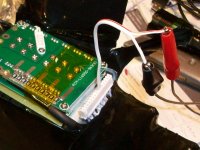Hi all.
I've built a 10s 6p battery pack, and I can't get the balancing BMS to balance. Looking at the specs for the BMS, it says that when a pack gets to 4.18V, a balancing charge of 35 mA is applied. But of course, even my smallest charger applies way more current than that, so the whole thing gets to the shut-off voltage before any real balancing can occur. When any one pack reaches 4.25V, the BMS shuts all charging down until that pack gets below 4.15V.
Neither of my chargers appears to be able to come back on after reaching max voltage. I've been trying to go through multiple cycles of letting it top out, then rest for awhile to drain the high packs, then unplug to reset and plug it back in again. But it really isn't working very well. After replugging, it only charges for a very short time and then shuts off again. And I'm afraid all the topping up is bad for the high cells. So I did some manual balancing, but I'd like to have a better solution for the long term.
I'm wondering if it would make sense to get a high-ohm, high-wattage resistor and put it in line with the charger output. Theoretically that would reduce the charge current so that I'm not overwhelming the balancing function. I'd just use it right at the end of charging every once in awhile to rebalance. Is this a good idea or no?
Thanks in advance.
ETA: It looks like the failure to re-start charging is with the BMS. The balancing function both turns on and releases at 4.18V, but the over-voltage shutoff does not release until 4.15. So if any one pack gets up to 4.25V, the BMS shuts off charging, and discharges that pack to 4.18V. But because it never gets down to 4.15V with the balancing current, the BMS never releases the over-voltage protection.
I've built a 10s 6p battery pack, and I can't get the balancing BMS to balance. Looking at the specs for the BMS, it says that when a pack gets to 4.18V, a balancing charge of 35 mA is applied. But of course, even my smallest charger applies way more current than that, so the whole thing gets to the shut-off voltage before any real balancing can occur. When any one pack reaches 4.25V, the BMS shuts all charging down until that pack gets below 4.15V.
Neither of my chargers appears to be able to come back on after reaching max voltage. I've been trying to go through multiple cycles of letting it top out, then rest for awhile to drain the high packs, then unplug to reset and plug it back in again. But it really isn't working very well. After replugging, it only charges for a very short time and then shuts off again. And I'm afraid all the topping up is bad for the high cells. So I did some manual balancing, but I'd like to have a better solution for the long term.
I'm wondering if it would make sense to get a high-ohm, high-wattage resistor and put it in line with the charger output. Theoretically that would reduce the charge current so that I'm not overwhelming the balancing function. I'd just use it right at the end of charging every once in awhile to rebalance. Is this a good idea or no?
Thanks in advance.
ETA: It looks like the failure to re-start charging is with the BMS. The balancing function both turns on and releases at 4.18V, but the over-voltage shutoff does not release until 4.15. So if any one pack gets up to 4.25V, the BMS shuts off charging, and discharges that pack to 4.18V. But because it never gets down to 4.15V with the balancing current, the BMS never releases the over-voltage protection.


